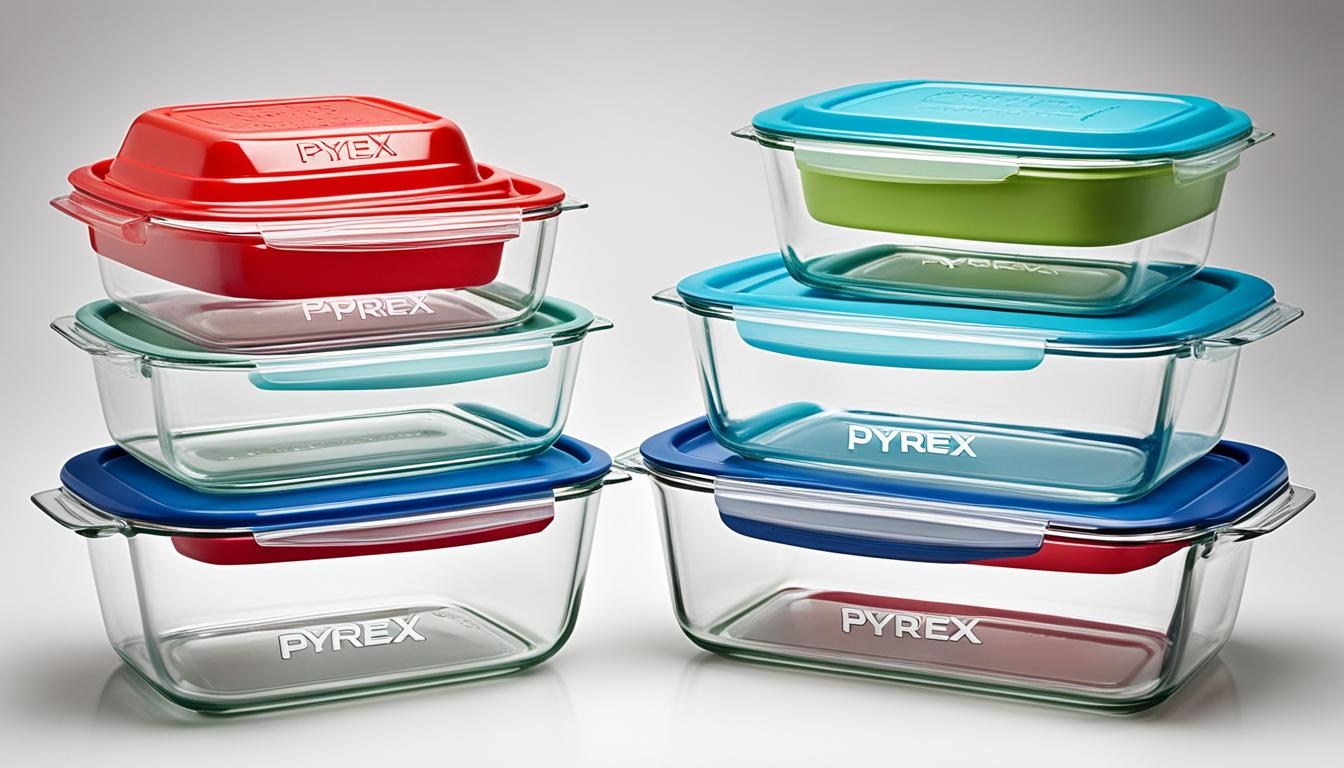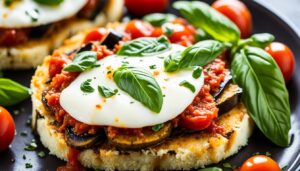Most of us know about the kitchen glassware brand Pyrex. But, have you seen PYREX spelled in all caps? Let’s dive into the differences between Pyrex and PYREX. We’ll discover what sets them apart.
Key Takeaways:
- Pyrex and PYREX are two variations of glassware with different glass compositions.
- Pyrex is made of borosilicate glass, known for its thermal shock resistance.
- PYREX is made of soda lime glass, which is not as resistant to extreme temperature changes.
- Borosilicate glass provides greater safety and durability in the kitchen.
- Proper handling and usage instructions are important for both types of glassware.
Types of Glassware in Home Kitchens
Most home kitchens use three basic types of glassware. There’s soda-lime glass, tempered glass, and borosilicate glass. Each one has its own benefits and best uses.
Soda-Lime Glass
Soda-lime glass is everywhere in kitchens. It’s chosen for glasses, cups, jars, and food storage containers. This glass is made from silica, soda ash, and lime, making it clear and tough. Yet, it can break if temperatures change quickly.
Tempered Glass
Tempered glass is a tougher kind of soda-lime glass. It’s been heated or chemically treated to be stronger. You’ll find it in baking dishes, cookware, and oven doors. It can handle high temperatures and is less likely to crack from heat shocks.
Borosilicate Glass
Borosilicate glass is known for handling temperature swings well. It’s crafted from silica and boron oxide. This type is perfect for baking or cooking in the oven as it doesn’t break easily from temperature changes. That’s why cooks and bakers love it.
| Glassware Type | Composition | Main Uses |
|---|---|---|
| Soda-Lime Glass | Silica, soda ash, lime | Drinkware, jars, food storage |
| Tempered Glass | Soda-lime glass treated with heat or chemicals | Baking dishes, cookware, oven doors |
| Borosilicate Glass | Silica, boron oxide | Oven-safe cookware, baking dishes |
Think about your needs when picking kitchen glassware. Whether it’s soda-lime, tempered, or borosilicate glass, taking care of it is key. This ensures your glassware lasts longer and stays safe.
The History of Pyrex
Pyrex began in 1915, introducing clear ovenware made of borosilicate glass.
This glass type was perfect because it could withstand sudden temperature changes.
Soon, it became a favorite in kitchens everywhere, changing the way we cook and bake.
“Pyrex glassware is perfect for cooking, serving, and storing food. It’s made of a special heat-resistant material called borosilicate glass, loved by professional chefs and home cooks.”
– Julia Child
Over time, Pyrex expanded its kitchenware line.
These products were strong, versatile, and became essential in homes.
But in the late 1990s, World Kitchen bought Pyrex and changed the glass used.
They switched to soda lime glass to save costs and reduce breakage.
This change made Pyrex more affordable and resistant to impacts.
However, it also lost some of its unique heat-resistant qualities.
The Legacy of Borosilicate Glass
Early on, Pyrex used borosilicate glass, which was special.
This glass doesn’t expand much with temperature changes, so it doesn’t break easily.
That made it perfect for all kitchen needs, from baking to storing.
Even after switching to soda lime glass, borosilicate’s legacy remains.
Fans and chefs still look for old Pyrex because of this durable, heat-resistant glass.
The Evolution of Pyrex
Although its glass changed, Pyrex is still a top brand for kitchenware.
Its products, like baking dishes and bowls, are loved by cooks.
Soda lime glass doesn’t change the durability or usefulness of Pyrex items.
With care, these Pyrex products perform well. They’re great for baking, cooking, or keeping food.
Now, let’s look at the differences between Pyrex and PYREX glass.
We’ll see how these differences affect their use in the kitchen.
The Difference in Glass Composition
The main difference between Pyrex and PYREX lies in the glass composition. Pyrex is made of borosilicate glass, known for its low thermal expansion and resistance to thermal shock. Meanwhile, PYREX is crafted from soda lime glass, more likely to break under extreme temperature changes due to its higher thermal expansion.
Borosilicate glass, being suitable for the kitchen, resists thermal shock well. With Pyrex, your dishes are safe. You can bake or chill without worry, thanks to its durability.
PYREX, made of soda lime glass, is reliable for daily kitchenware. It may not resist thermal shock as well, but it’s great for food storage and serving.
Knowing the difference between Pyrex and PYREX helps you choose the best glassware for your needs. Whether it’s thermal shock resistance or versatility you need, each has unique benefits.
| Glass Composition | Thermal Shock Resistance | Common Uses |
|---|---|---|
| Borosilicate Glass (Pyrex) | High | Baking, cooking, oven use |
| Soda Lime Glass (PYREX) | Lower | Food storage, serving, general kitchenware |
Both types of glassware offer advantages for different needs. Whether you choose borosilicate or soda lime glass, remember to handle with care and follow the maker’s advice. This ensures your glassware lasts long and stays safe.
Safety Considerations
When using glassware in the kitchen, always put safety first. Whether you handle Pyrex or PYREX, be careful to prevent accidents or breaks.
It’s vital to keep in mind thermal shock’s risks. Pyrex, made from borosilicate glass, handles thermal shock better than soda lime glass used in PYREX. But care is still needed with both.
Dr. Emily Thompson, a kitchen safety expert, says, “Always follow proper handling, cleaning, and storage guidelines. This ensures your glassware’s safety and longevity.”
Pyrex and PYREX may have warnings and instructions that are important to read and follow. These tips offer advice on handling and avoiding thermal shock.
To keep your glassware safe and prevent accidents, here’s what you should keep in mind:
- Handle with care: Be gentle and avoid hitting glassware on hard surfaces, which can make it more likely to break.
- Avoid sudden temperature changes: Let glassware cool before moving it to a much cooler or hotter place. This prevents shock.
- Use appropriate cookware: Make sure your glassware is right for what you’re doing, like baking or storing food.
- Follow cleaning guidelines: Clean glassware as the maker suggests. Don’t use rough cleaners or chemicals that can harm it.
- Store properly: Keep glassware where it won’t easily fall or break, for its safety.
By sticking to these tips and guidelines, you and your family can safely enjoy using glassware in your kitchen.
The expert’s advice
Dr. Emily Thompson stresses the need to be careful with glass. She says:
“Glassware is found in all kitchens, but remember it can break and be dangerous. Whether it’s Pyrex or PYREX, always read and use them as advised. Taking steps like avoiding quick temperature changes helps avoid accidents and extends your glassware’s life.”
Keeping safety in mind when using glassware in the kitchen makes cooking more enjoyable and worry-free.
Availability of Pyrex and PYREX
In the United States, South America, and Asia, you’ll mostly find pyrex glass. It’s made of soda lime glass. In Europe, Africa, and the Middle East, PYREX is available and is made of borosilicate glass. Knowing the difference is key when buying glassware in various regions.
In the United States, South America, and Asia, pyrex is common. It is made of soda lime glass. You can easily find it in stores or online. It’s perfect for everyday kitchen needs.
In Europe, Africa, and the Middle East, you can find PYREX. This glass can better withstand sudden temperature changes. It’s great for cooking and baking. Though it’s rarer, select retailers and online sites offer it.
Knowing the type of glass is crucial when looking at Pyrex and PYREX. Where both types are available, think about what you’ll use it for, your budget, and your preferences before buying.
Why the Switch to Soda Lime Glass
Kitchenware now uses soda lime glass instead of borosilicate because of costs and boron’s toxicity. Borosilicate glass can handle rapid temperature changes because it has boron. But, boron is rare and expensive. This made borosilicate glassware costly to make, raising production costs.
Getting rid of borosilicate glass was hard because it had boron in it. The steps to get, refine, and throw away boron were bad for the environment and complicated. Soda lime glass is cheaper to make and doesn’t have boron. This makes it a better choice for both price and the planet.
The Cost Factor
Cost was a big reason why manufacturers picked soda lime glass for making kitchenware. It allowed them to lower the cost of making glassware. This made the final products cheaper for us to buy. It made glassware easier to get for more people, which was good for buyers.
Toxicity of Boron and Environmental Considerations
Boron in borosilicate glass made it tough to deal with because of its toxicity and disposal issues. Borosilicate glass is safe to use every day, but getting and refining boron could hurt the environment. Throwing away glassware with boron needed special steps to avoid damaging the ecosystem. Soda lime glass doesn’t have boron, making it less of an environmental problem and easier to get rid of.
Soda Lime Glass: Resistant to Mechanical Stress
Soda lime glass is what PYREX kitchenware is made of now. It’s good at resisting breakage from being knocked around. This toughness is great for use in the kitchen, like for keeping food, making meals, and serving them.
It doesn’t crack or shatter easily when knocked around, making it a trustworthy choice for kitchenware. It can handle daily use well. This means it lasts longer, which saves money and makes for a better experience.
By choosing soda lime glass, kitchenware makers have solved issues related to cost, boron’s toxicity, and the trouble with throwing away borosilicate glass. This change has made kitchenware cheaper, tougher, and better for the earth. Using soda lime glass shows a big commitment to making kitchenware more reachable, safe, and green.
Shattering Reaction of Glassware
Glassware breaking, like Pyrex, often happens because of thermal shock. This is when the glass quickly expands or shrinks due to sudden temperature changes. It causes stress and sometimes, the glass breaks. Even though Pyrex is made of toughened glass, it can still break under extreme conditions.
Tempered glass is made stronger through a special heating process. It’s built to handle quick changes in temperature better. But, it’s not as strong as borosilicate glass. This type has superior resistance to quick temperature changes.
If tempered glass faces too fast or extreme temperature changes, it might break. Especially if the shift in temperature puts too much stress on it. So, it’s vital to be gentle with these items. Avoid exposing them to sudden temperature differences.
The Difference in Uses
Pyrex and PYREX serve different needs in the kitchen. Pyrex, made from borosilicate glass, is great for baking and cooking. It handles extreme temperature changes well. This makes it safe for baking in the oven.
PYREX, crafted from soda lime glass, is used for everyday kitchen tasks. It’s good for food storage and serving. PYREX is durable and versatile, making it a kitchen favorite.
Both Pyrex and PYREX are great for different kitchen activities. Whether baking a casserole or storing food in the fridge, they’re reliable choices.
Benefits of Pyrex for Baking
Pyrex’s borosilicate glass is perfect for baking. Let’s look at some benefits:
- Thermal shock resistance: Pyrex can handle quick temperature changes. It’s great for ovens and hot dishes.
- Even heat distribution: Pyrex spreads heat evenly for consistent baking results.
- Easiness to clean: Pyrex is dishwasher-safe. It doesn’t stain or hold odors.
- Non-reactive surface: Pyrex’s surface doesn’t absorb flavors or odors, keeping your baked goods pure.
Using Pyrex for baking ensures tasty, evenly cooked dishes. It’s a must-have for anyone who loves to bake, offering thermal shock resistance and more.
Versatility of PYREX in the Kitchen
PYREX is great for many kitchen needs. Here are some uses:
- Food storage: PYREX is great for keeping leftovers and ingredients fresh. You can see what’s inside easily.
- Serving dishes: PYREX bowls and platters are both pretty and functional. They’re perfect for showing off your cooking.
- Microwave-safe: You can reheat food in PYREX glassware. It’s microwave-friendly.
- Dishwasher-safe: Cleaning PYREX is easy. It’s dishwasher-friendly.
PYREX’s versatility and strength make it a top choice for kitchen tasks. It’s great for storing, serving, and reheating food. PYREX is handy in any kitchen.
Aesthetics and Design
Pyrex and PYREX are not just practical. They also look good. They have vibrant mixing bowls and elegant serving dishes. These brands make kitchenware that is both useful and decorative.
The image above shows the different ways you can use Pyrex and PYREX in the kitchen.
The Importance of Proper Handling
It doesn’t matter if you use Pyrex or PYREX, handling it the right way is key. Both come with directions that you should follow to stay safe.
Proper handling includes:
- Avoiding sudden temperature changes: Glassware, like Pyrex and PYREX, can’t take quick temperature shifts. You shouldn’t shock glass by moving it from hot to cold too fast, or vice versa. It’s best to change temperatures slowly to keep it from breaking.
- Using appropriate cookware for different applications: Pyrex and PYREX are great at handling heat, but they each have their best uses. Use Pyrex for baking and cooking with big temperature changes. PYREX is better for storing and serving food.
- Practicing caution when cleaning and storing the glassware: Be gentle when washing glass to avoid damage. Don’t use rough cleaners or chemicals that could harm the glass. Make sure they’re dry and stored safely to avoid drops or knocks.
Remember that glassware, like Pyrex and PYREX, can break easily if not handled correctly. Taking care of your glassware not only makes it last longer but also keeps you safe from harm.
“Handle glassware with care to avoid breakage and accidents.” – Pyrex Safety Guidelines
Conclusion
In conclusion, Pyrex and PYREX differ in their glass types. Borosilicate glass is used in Pyrex, making it more resistant to temperature changes. PYREX uses soda lime glass, which can break more easily under extreme temperatures. Knowing this can help you pick the right glassware for your kitchen needs.
When choosing glassware, it’s key to know these differences. Pyrex is great for cooking and baking, where temperatures change quickly. It’s safe and lasts longer. PYREX, made of soda lime glass, fits general kitchen uses like storage and serving better.
To keep your glassware in good shape, follow safety and handling tips. Always read and stick to the warnings and instructions that come with your glassware. Knowing about the glass types helps you make smart choices. This way, you get the most from your high-quality glassware at home.





